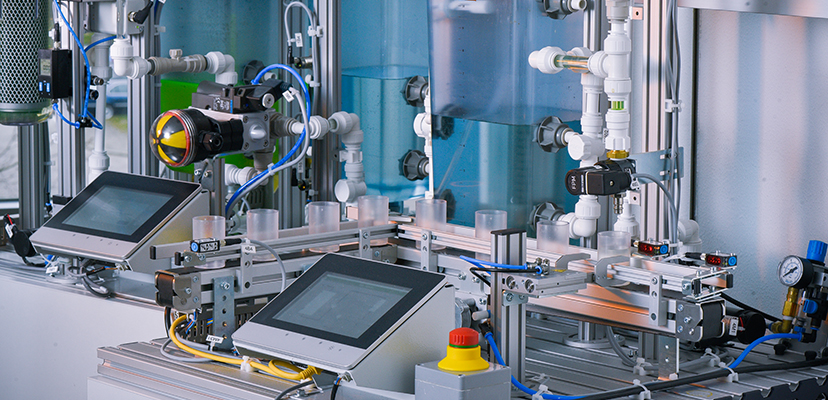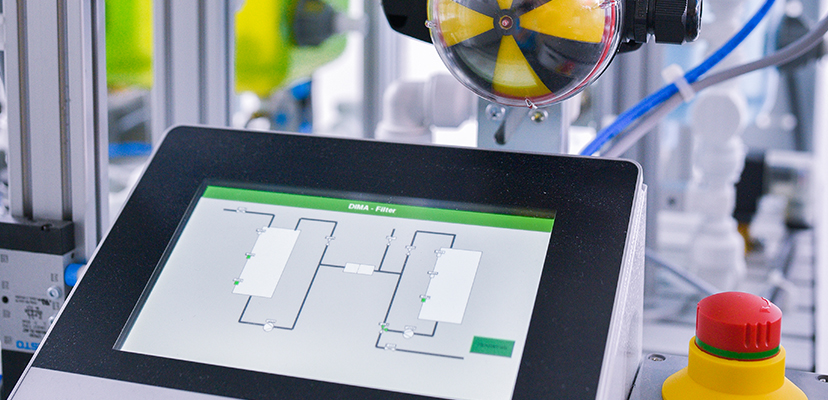


With DIMA, WAGO presents a new, manufacturer-independent solution for automating modular systems which significantly reduces plant engineering and facilitates future system modifications. DIMA links modularity and Industry 4.0 approaches into a winning value added process over the entire lifecycle of a facility, from design up to recycling.
At the Annual General Meeting of NAMUR in November 2014, WAGO presented the Industry 4.0-leading DIMA (Decentralized Intelligence for Modular Applications) concept. Developed in collaboration with Germany’s Dresden University of Technology and Helmut Schmidt University of Hamburg, DIMA is an approach for the automation of modular process applications to significantly shorten an application’s integration engineering. Beyond upfront engineering, DIMA simplifies future application upgrades. MTP (Module Type Package) is the centerpiece of the DIMA approach: a new way of defining the description for process technology application modules. In this module description model, information is stored that is necessary for user-independent integration of an application module into the process control system of an application.
In the spring of 2015, the NAMUR interest group commissioned the development of a standardized integration solution based on WAGO’s DIMA concept. The goal was to specify the MTP presented by WAGO in the areas of process management, visualization, alarm management and diagnostics. WAGO, and their university partners, had implemented the DIMA concept as a prototype in parallel with this. The system demonstrator enabled WAGO to prove that the method was not only practical, but that the exchange of entire system modules was possible in as little as three minutes.
DIMA networks
DIMA thus provides an enormous contribution to versatile production – and is in greater demand than ever in an environment of increasingly dynamic market change. The desire for individualized goods leads to an ever increasing variety – up to and including the production of customized products. The global availability of good also cause fluctuations in incoming orders and displacements in regional markets. Business should therefore have production processes which are universal, mobile, scalable, modular, and compatible. This, in turn, requires processes which can be adapted to quickly changing needs, and which deliver transparent, relevant production data, for example, those that provide information on delivery capacity.
This need to record, evaluate, store, and provide operating data and lifecycle information assumes that the facility is modular, that each system modules is equipped with its own intelligence, and that they system modules are able to communicate with each other and with the process control system. Only then can the control level penetrate to every parameter of the system, and only then can the collected data be definitively assigned and analyzed, without being lost in an information overload. The automation components used for this must have a standardized interface, such as the MTP interface provided by DIMA. Only then can all components be networked and integrated across the entire lifecycle on the path to Industry 4.0.
DIMA changes the value adding processes
Due to this type of modularity – of the physical plant as well as the automation system – the information technology communication changes within the system, the plant engineering, and the system operation, and also the added value linked to this. A modular system can thus consist of a number of different modules in various configurations over the lifecycle of the system. A module can, in turn, be used in several different systems. The lifecycle of the system thus differs substantially from that of a system module. By using DIMA, this situation can be exploited to increase yields across the entire value added chain of a production system, which affects the module manufacturers, the system designers, and the operators.
Advantages for module manufacturers and system operators
DIMA divides the process of plant engineering into two phases: the design of the module and the integration of the module into a system. Designing the individual system modules is the responsibility of the module manufacturer. The manufacturer has expert knowledge of the module and the corresponding processes within the module. DIMA provides a neutral interface between the system and the module so that module manufacturers can protect their proprietary information, and system operators can maintain confidentiality about their production procedures. Due to DIMA, the module manufacturer gains economic independence from the system designer. Therefore, the manufacturer is no longer compelled to develop customized or project-based system modules, and can turn instead to series product manufacturing, which leads to independence from the system designer, both in terms of finances and time. This allows the module manufacturer to develop a sound, “standardized” module, subject it to extensive testing, improve it over the long term, and provide it on short notice. This is far more economical than having to provide customized system modules that match the proprietary environment of the system designer.
Using DIMA, the module manufacturer can deliver modules for the system using the just in time approach. This reduces capital commitment on the part of the system designer. No proprietary expertise is required to carry out maintenance on individual modules, which lead to a further reduction in costs. The system designer is also exposed to fewer risks, as the warranty and expertise for the module are now tied to the manufacturer.
The integration of individual modules into a system is carried out by the system engineer or operator. Due to DIMA, the system designer can assemble the best modules available from different manufacturers without having to consider their process technology characteristics. By using DIMA, the user interface maintains a uniform look and feel, even though the system modules were produced and delivered by different suppliers. DIMA functions using a reference to operating libraries for this purpose.
During system engineering, the system designer merely loads the MTP into the process control system and physically links the module to the system backbone. The process control system of the complete system and the module can then communicate directly with one another using plug-and-produce. This engineering procedure requires less than three minutes per module; in contrast to the days, weeks, or months that were necessary for designing a system without DIMA. Once the system is set up, the production line can be quickly converted or retrofitted using DIMA by exchanging individual modules or by integrating them multiple times into the overall system architecture as part of a “numbering up” approach. This allows system operators to flexibly react to changing market requirements.
Finally, individual system modules can be retired with no impact on the overall system because they are recycled at the module level. The exchange can be appropriately contracted with the module manufacturers and carried out by their experts. In this context, leasing modules becomes a real possibility.
Horizontal and vertical integration according to Industry 4.0
The business processes of module manufacturers and system operators are horizontally linked at a much greater level with DIMA than previously, because the selection and use of modules requires close collaboration. Within this context, the system operator merely defines a process technical functionality, while the module manufacturer offers a service bundle included availability, service, and maintenance of this functionality, which is encapsulated with each module, for example, on the basis of a service level agreement. System operators can outsource the complexity to the suppliers and can thus focus on their core competencies. This new form of collaboration benefits the module manufacturers, in that they have continuous access to the operating and usage information about their modules, and can then consistently improve the modules on the basis of this data.
The vertical integration of information technology into the value added chain of module manufacturers, system operators, and system designers is carried out using “module type packages”, which are the digital description of the system modules. This is automatically generated by the module manufacturer’s software tool, and then automatically imported into the system operator’s process control system in order to identify the modules and their services to the process control system.
DIMA – Essential Industry 4.0 component
Regardless of how Industry 4.0 is implemented in the future, it will require the use of “cyberphysical systems”, which are characterized by the linking of components, e.g. a machine, controller, or sensor, with a corresponding virtual representative. The virtual representative reproduces the physical component, manages and controls it as a resource on a virtual market place, and thus enables interaction between different “cyber-physical systems”.
When projected onto DIMA, the autonomous system module represents the physical object, while the “module type package” provides a path for implementing the virtual representative in the information network. The MTP already represents the functions of the system modules and manages them in the architecture of the overall system. It is thus a facilitator for Industry 4.0 and DIMA, and therefore functions as a first actual module in solving the challenges posed by Industry 4.0.
Text: Thomas Holm and Eva Banzholzer, WAGO
Photo: Fotolia, WAGO